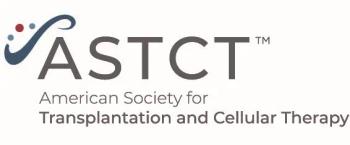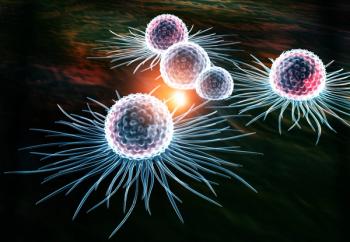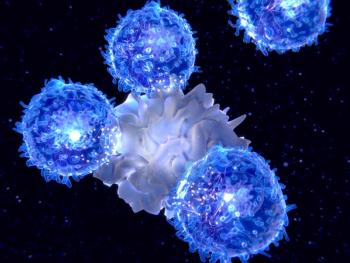
State of CML Treatments
In this interview, we discuss the current state of therapies available in treating CML patients and the role of newer agents.
Chronic myeloid leukemia (CML) is now seen as a classic example of a malignancy driven by a mutation, the BCR-ABL fusion gene on the Philadelphia chromosome. This fusion gene produces a continuously active tyrosine kinase that is thought to drive CML. The first small molecule inhibitor against BCR-ABL approved by the US Food and Drug Administration (FDA) was imatinib, or Gleevec. There are now several newer BCR-ABL inhibitors that can treat CML patients resistant to this earlier targeted therapy. Today, we are speaking with Michael Mauro, MD, of the Memorial Sloan-Kettering Cancer Center in New York and formerly of the Knight Cancer Institute in Portland, Oregon, and Dr. Jerald Radich, of the Fred Hutchinson Cancer Research Center in Seattle. Both Dr. Mauro and Dr. Radich are involved in clinical research into the genetics of CML and how to optimize care for these patients with CML.
-Interviewed by
Cancer Network: Dr. Mauro, can you give a brief overview of how Philadelphia chromosome–associated CML typically develops and how imatinib changed the course of the disease?
[[{"type":"media","view_mode":"media_crop","fid":"17997","attributes":{"alt":"Michael Mauro, MD","class":"media-image media-image-right","id":"media_crop_5938027376838","media_crop_h":"0","media_crop_image_style":"-1","media_crop_instance":"1196","media_crop_rotate":"0","media_crop_scale_h":"0","media_crop_scale_w":"0","media_crop_w":"0","media_crop_x":"0","media_crop_y":"0","style":"float: right;","title":"Michael Mauro, MD","typeof":"foaf:Image"}}]]Dr. Mauro: CML is a unique cancer in that it is driven by a single oncogene. We know a lot about the underpinnings of the mechanism, and as you described, we’re talking about a constitutively activated tyrosine kinase, which is the product of a genetic fusion. How and why that happens is probably what we know least about, but suffice it to say, it is probably a fairly common genetic error that happens during a chromosome exchange during cell division and leads to a malignancy. Why we see this genetic error in many more patients than we actually see diagnosed with CML is not clear, but CML remains a fairly rare cancer-about 5,000 new cases per year in the United States; that is about 1 to 2 per 200,000 in the population. It typically develops with the patient having nonspecific symptoms that they don’t necessarily associate with a specific problem or something ominous, such as weight loss, night sweats, fevers, chills, abdominal symptoms. It is often diagnosed by serendipity-they often go for other reasons, or have blood work or other tests done for something unrelated, and lo and behold, they have an elevated white blood cell count, and are therefore further worked up with blood tests, bone marrow tests certainly, and we make a diagnosis of CML.
CML generally presents in the chronic or early stage where it is indolent, it is proliferating and causing symptoms, but it is not necessarily as unstable as more advanced CML. Historically, we used to treat this with simple drugs to control the blood counts as a first step, to reduce the elevated white blood cell counts and elevated platelet counts that can be seen at presentation, and to diminish symptoms. Definitive therapy options were mainly interferon, an immunomodulatory and anti-proliferative agent, for which we also don’t know the mechanism of action, as well as other medications. This was effective in a good number of patients, a minority, but for the majority it was difficult to take. Imatinib really did change the course of disease by offering a selective, oral drug with a high degree of efficacy and an efficient way to clear the leukemia. It took patients who were intolerant to or failed interferon and put the majority of them into remission. It became our first approved drug and revolutionized our treatment of CML.
Cancer Network: There are now four other BCR-ABL kinase inhibitors that are approved. Dr. Radich, can you talk about how these are different?
[[{"type":"media","view_mode":"media_crop","fid":"17999","attributes":{"alt":"Jerald Radich, MD","class":"media-image media-image-right","id":"media_crop_2489257887769","media_crop_h":"0","media_crop_image_style":"-1","media_crop_instance":"1199","media_crop_rotate":"0","media_crop_scale_h":"0","media_crop_scale_w":"0","media_crop_w":"0","media_crop_x":"0","media_crop_y":"0","style":"float: right;","title":"Jerald Radich, MD","typeof":"foaf:Image"}}]]Dr. Radich: From a historical perspective, there were two drugs, dasatinib and nilotinib, that were approved first for patients in the setting of intolerance or resistance to imatinib; that is patients who either couldn’t tolerate imatinib because of side effects, or the patients who failed to get a response or who had a response and then became resistant. After that, there were two clinical trials comparing the new second-generation drugs, one comparing dasatinib with imatinib and one comparing nilotinib with imatinib. Both of those, the new second-generation drugs that are more potent than imatinib showed faster response to cytogenetic remissions, faster response to what we call major molecular remission, which is 1,000-fold reduction in the disease bulk and less progressions-the thing we really fear in CML, the transition from a chronic phase to accelerated phase, or beyond to blast crisis. In those two trials-and it may be just because the patients weren’t followed long enough-there was no difference in survival between either of the second-generation drugs or imatinib. A couple years later, bosutinib and ponatinib were approved, both for the similar setting of intolerance and resistance, and like dasatinib and nilotinib, are fairly effective in intolerant and resistant settings. So now we have two drugs, dasatinib and nilotinib, that you can use in frontline or in resistance. And you have bosutinib and ponatinib that can be used in the intolerant and resistant settings. There is currently a trial going on with ponatinib upfront compared with imatinib to see if it can also be used in the frontline setting.
How these drugs are different are the spectrum of kinase inhibition and how they actually inhibit BCR-ABL. BCR-ABL inhibitors are not completely clean; they not only inhibit tyrosine kinases but also can inhibit other families of kinases called SRC kinases. The degree that they inhibit those various types of kinases reflects on the different spectrum of side effects they may have. For instance, dasatinib has more pulmonary toxicity, bosutinib has more gut and diarrhea toxicity, ponatinib has more pancreatic toxicity, and nilotinib has more rash. That activity also translates to how the drug binds BCR-ABL and how it affects resistance. So, while many of these drugs will inhibit many mutations that occur in resistance, some are better at inhibiting some mutations vs others, and that just happens to be how that drug fits into the BCR-ABL kinase domain and how it blocks that function. Ponatinib actually appears to be sensitive to all of the kinase mutations detected so far, including the T315 mutation, which has been the bugaboo previously because neither imatinib or dasatinib, nor nilotinib or bosutinib have shown any response when patients reveal that mutation.
Cancer Network: What are main approaches to treating a newly diagnosed CML patient? What are the factors that need to be considered to decide on the best course of treatment? Dr. Mauro, let’s start with you.
Dr. Mauro: As Jerry mentioned, the trials comparing second-generation drugs, dasatinib and nilotinib, showed that there was some benefit; there was a gain but not much of a penalty. There was a little bit more in the way of new toxicities and perhaps a bit of myelosuppression but not so much. We have three choices for a newly diagnosed patient. You are looking for the best fit; you want to find the drug that is the most effective at putting the disease into remission quickly, efficiently, and timely, because timely remission really matters. You also want a drug that is tolerable over the long term because patients are expected to stay on treatment indefinitely. Now that is an active area of research-whether that is ultimately going to be what is required for all patients-but it is still the assumption now. What I am alluding to is that there are some trials looking at potentially
Dr. Radich: To add to what Michael is saying, I think there are three principal things we consider when a patient walks in the door. One is, like Michael said, the phase the patient is in, and even if the patient is in chronic phase, there are some clinical scores you can give to patients. The common one is the Sokal score (which looks at spleen size, the types of white blood cell counts the patient has, the number of blasts, etc), and gives you a score that is pretty solid in predicting response. And it appears that patients who have higher Sokal scores might do a little better by being given the second-generation drugs. Similarly, if someone walks in the door and it looks like they have fairly advanced chronic phase, maybe sloping towards the brink of accelerated phase, those patients need to get the second-generation compounds. The patients who have really minimal, low Sokal scores might just do on imatinib. The other thing is the underlying comorbidities. We talked about dasatinib having more pulmonary issues, bosutinib with more pancreatic issues. Based on the profile of the known toxicities of the drug, if the patient obviously has comorbidities that clash with the toxicities, that will guide which drug should be used. The last factor is physician familiarity with these drugs. CML is not a public health menace, as Michael mentioned. A lot of doctors in the community have not seen very many of these patients at all. So, they may have only used imatinib or dasatinib, and it means a lot to be familiar with the problems you should anticipate with each drug. Often, if all things are equal and the physician has only extended experience with one drug, that is a perfectly good reason to start with that drug.
Cancer Network: How is resistance to a therapy typically defined? Are there any issues with identifying patients who may be resistant to the kinase inhibitor therapy they are on?
Dr. Mauro: The point Jerry just made about better risk stratification of patients is good. What would be ideal is to understand if patients perhaps have the underpinnings or routes of resistance right at presentation, which would be a paradigm shift in CML. But we don’t, so we really judge resistance based on response criteria. We look to see based on what the data show, what the expectations of responses based on trials are; how fast should a patient respond? I mentioned the 3-month time point at which we look for a degree of molecular response, log reduction at 3 months or perhaps 6 months, depending on which guidelines you trust the most, the European Leukemia Net or the National Comprehensive Cancer Network guidelines. Cytogenetic response should really be complete by a year, and the 1,000-fold reduction in major molecular response Jerry mentioned should be complete by 12 to 18 months. Patients not meeting those milestones are not considered resistant. Of course, if a patient relapses or proliferates on treatment, that is clear resistance. And in getting into the underpinnings of resistance, we now know that the most common phase of resistance of CML in half of patients with inadequate clinical response, or loss of response, is a kinase domain mutation, as Jerry was discussing with the different compounds and their different activities. So, with suspicion or clear evidence of resistance, you want to look for kinase domain mutations to potentially guide therapy. Likely guiding therapy due to an underlying mutation result is still only in a minority of cases, meaning only a minority of the results you get will tell you about specific drug choices, and in many cases, more than one drug is reasonable to choose in the face of different mutations.
Dr. Radich: Roughly half of the cases of resistance are from point mutations that can help guide therapy and the rest are by some mechanisms we have yet to understand. It is interesting that patients who are resistant in chronic phase share some genetic features with patients who have advanced phase disease, when you do a more high-powered genetic analysis. And in the past it has been shown that patients who develop resistance are a bit faster to go to accelerated phase and blast crisis than the average patient. The genetic program that underlies progression is really what is at play in patients who become resistant or will relapse who don’t have ABL mutations. That is certainly an area of ongoing research, and we certainly don’t know how to predict or completely tackle that at this point.
Dr. Mauro: I agree. The signature of resistance is a kinase mutation, but the roots of it are still things we may not understand. But the good news is that we have five drugs to choose from and many different ways to move within a pretty safe area of treatment-an oral treatment of once- or twice-a-day therapy with really tolerable side effects that will get most patients in remission quickly and to maneuver into other therapies, but we still have a lot to learn.
Dr. Radich: Just to echo what Michael said: We spend a lot of time and effort worrying about resistance and the like, but when you step back, we are in a really enviable position in CML these days, with an embarrassment of riches with active drugs, and it is really quite remarkable how this disease has changed so quickly. When I first started, I won’t tell you how long ago, it was like in the Ice Age, but even 15 years ago, with CML the primarily curative strategy was transplantation and in basically a little more than a decade, transplantation is really done, it is not needed.
Cancer Network: Thank you so much to both of you for joining us today.
Dr. Mauro: Thank you!
Dr. Radich: Thanks!
Newsletter
Stay up to date on recent advances in the multidisciplinary approach to cancer.


















































































